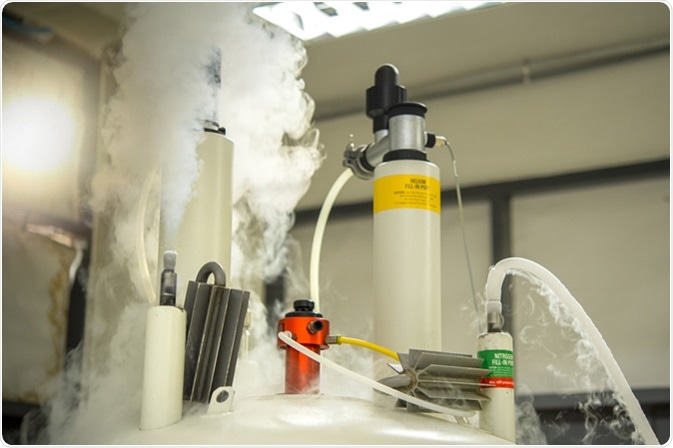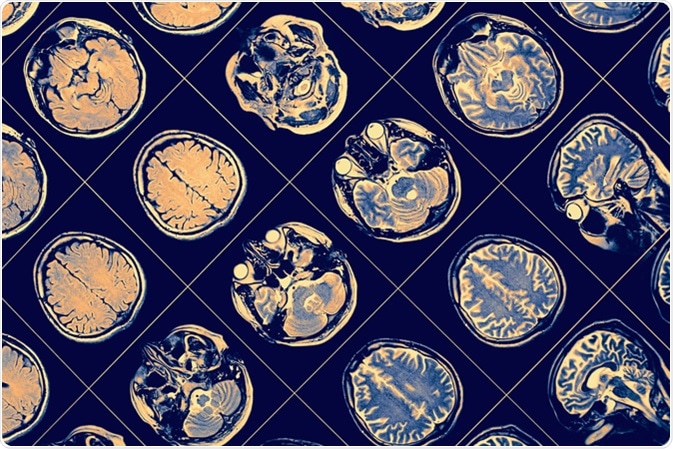A common limitation of NMR spectroscopy is insufficiently concentrated samples, owing to the low sensitivity of the technique and depending on the application. One of the broader limitations is magnetic field drift, which is highly detrimental to NMR spectra. Most of these limitations can be overcome by alterations in methods or by corrections following spectra acquisition.

Scientists are adding nitrogen to the Nuclear magnetic resonance spectroscopy (NMR) to keep the temperature cool and to prevent volatile helium gas (He). Image Credit: Rabbitmindphoto / Shutterstock.com
Sensitivity
While NMR spectroscopy is highly versatile, it often fails due to its low sensitivity. This is due to the magnetic resonance aspect of NMR, which has weak interaction energies involved. This can be beneficial in situations where it is desirable to keep the samples undisturbed, but it is a significant disadvantage when examining complex reactions, certain biological processes, and metabolomics.
Thankfully, there are several methods that allow a technician to overcome these limitations. For one, sensitivity can be improved to some extent by optimizing the hardware used for NMR experiments. For example, the signal to noise ratio can be improved by raising the concentration of the target analyte or by encouraging quicker recovery of magnetization of spins. The magnetic coils of NMR hardware can also be optimized to result in the coupling between it and the sample, resulting in stronger signals at particular frequencies.
NMR experiments are carried out in static magnetic fields, which can limit the usefulness of NMR spectra. The magnetic field can also be increased during experiment execution, which affects the nuclear spin level’s Boltzmann population and Larmor frequency. This in turn results in increased intensity of NMR signals.
Boltzmann distributions can also be used to enhance the signal to noise ratio via enhancing population differences, which thus enhances the nuclear spin system’s polarization further than their Boltzmann distributions.
An example of this is dynamic nuclear polarization (DNP and d-DNP NMR), wherein electron spin polarization is transferred to nuclear spins using microwave irradiation near the electron Larmor frequency. D-DNP in particular has been cited for its advantages when used on samples of physiologically relevant concentrations.
Dynamic nuclear polarization techniques and their ability to increase sensitivity have been paired with micro coils to improve sensitivity. These coils, which can be used to target radiofrequency circuitry to improve sensitivity, can also be paired with photochemically induced DNP (photo-CIDNP) to improve sensitivity.
In such cases, the target molecule and a photoexcited photosensitizer (e.g. flavin) form a radical pair that is continuously irradiated by the micro-coils and avoids photodegradation products interfering with detection. The net result is less degradation of flavin and improved sensitivity of the data collected.

NMR image of human brain. Image Credit: sfam_photo / Shutterstock.com
Magnetic Field Drift
Drift in the magnetic field affects all magnetic resonance technology, including magnetic resonance imaging (MRI) and nuclear magnetic resonance (NMR) spectroscopy. It can lead to spectral peaks broadening and lineshapes being distorted, making interpretation of NMR results very difficult.
When solution NMR spectroscopy is used, the issue is relatively easily solved via corrections of the magnetic field during measurement recording. To do this, deuterium present in NMR solvents is detected enabling tracking of the field drift, with subsequent adjustments of the main field being done using electromagnets at room temperature.
Magic angle spinning (MAS) NMR measurements cannot correct for magnetic field drift using this method, because the sample is present in only small volumes, thus the presence of deuterium is very low. Not having a lock, as in solution NMR, makes tracking and correcting drift difficult.
Recently developed methods have attempted to account for the drift in the spectra, rather than during acquisition. These methods included using shorter blocks of data acquisition paired with calculating a linear phase ramp from the drift in each experiment and applying it to all spectra across all dimensions.
Algorithms have proven to be to capable of correcting drift in multidimensional spectra, up to 4D. Furthermore, the algorithm can be applied to data recorded as planes, points, or by non-uniform sampling. The correction results in improved intensity and shape of the peaks.
Sources
- Ardenkjaer-Larsen J.H., et al. (2015). Facing and overcoming sensitivity challenges in biomolecular NMR spectroscopy. Angewandt Chemie International Edition. https://doi.org/10.1002/anie.201410653
- Najbauer E.E. and Andreas L.B. (2019). Correcting for magnetic field drift in magic angle spinning NMR datasets. Journal of Magnetic Resonance. https://doi.org/10.1016/j.jmr.2019.05.005
- Mompean M., et al. (2018). Pushing nuclear magnetic resonance sensitivity limits with microfluidics and photo-chemically induced dynamic nuclear polarization. Nature Communications. https://doi.org/10.1038/s41467-017-02575-0
Further Reading